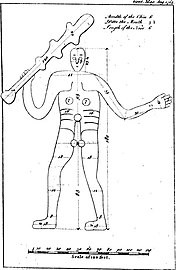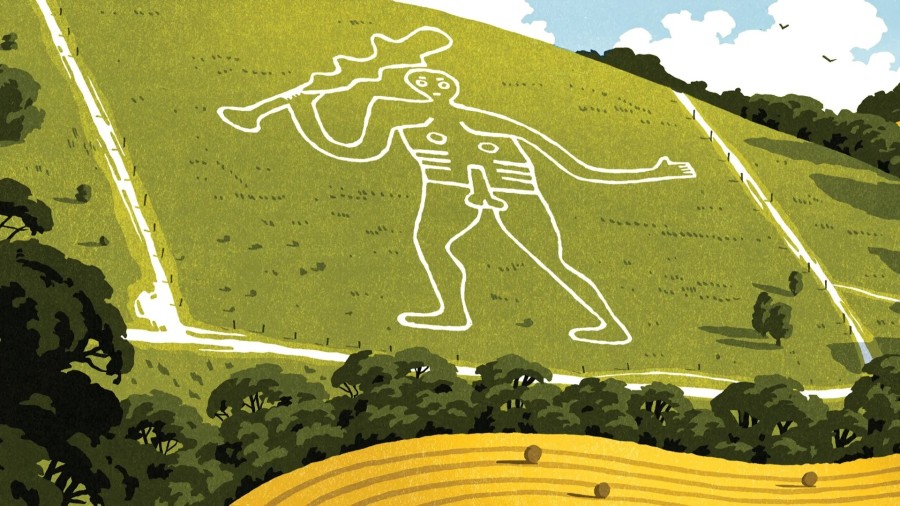Cerne Abbas Giant may have been carved into hill over 1000 years ago

The Cerne Abbas Giant
National Trust Images/Mike Calnan/James Dobson
A mysterious chalk carving of a huge, naked man on an English hillside was made in the 10th century, according to the first attempt to archaeologically date the giant. The finding is unexpected because the earliest mentions of the Cerne Abbas Giant are from just over 300 years ago, suggesting it was forgotten for centuries.
Historians and archaeologists had many ideas about when the giant was constructed, says team member Mike Allen, an independent geoarchaeologist at Allen Environmental Archaeology in Codford, UK. “Everyone was wrong.”

The giant is carved into a hillside overlooking the village of Cerne Abbas in southern England. It is a figure of a man with a large, erect penis, holding a club. It was made by digging trenches into the hillside, then filling them with white chalk.
The earliest known reference to the giant is from 1694, from the records of the church in Cerne Abbas. The giant is absent from earlier records, notably a 1617 survey of the area by John Norden, who was famously thorough.
Historians have argued for decades over when the giant was created and what it represents. Some believe it was made in the 1600s, in line with the historical records, while others think it dates to Roman times.
Allen is part of a team that carried out excavations on the giant in 2020, with the support of its owner, the National Trust. The researchers dug in the soles of both its feet and the crooks of its elbows.

The team looked for grains of quartz in the chalk and in the soil next to the trenches. A method called optically stimulated luminescence dating could then be used to determine when the quartz was last exposed to sunlight.
Using the technique, the researchers dated the oldest chalk to between AD 650 and 1310. The giant was probably created sometime between these dates, with the year AD 980 falling in the middle of that window. In theory, the giant might be older, because the chalking has been replaced several times. But the soil data suggests not. The oldest date for the soil is AD 700 to 1100. “[The giant] cannot be older than that,” says Allen.

Intriguingly, a Benedictine monastery was founded in Cerne Abbas in the late 10th century. Allen speculates that the giant might represent a response to that.
“It would almost seem to be an act of resistance by local people to create this fantastically rude pagan image on the hillside,” says Alison Sheridan, a freelance archaeological consultant based in Edinburgh, UK. “It’s like a big two fingers to the abbey.”
It isn’t clear why there are no mentions of the giant for centuries. Allen says other findings from the excavation hint there was a time when the site was covered with long grass, suggesting the giant became overgrown and invisible.
However, Timothy Darvill at Bournemouth University, UK, says prehistoric monuments were often ignored. “Even sites like Stonehenge don’t get that much mention,” he says.
The giant is one of only three surviving “ancient” hill figures in England. The others are the Long Man at Wilmington and the Uffington White Horse. Only the horse can safely be said to be prehistoric, however.
Related Post
A shocking documentary proves that mermaids do exist
SHOCKING Revelation: Thuya, Mother of Queen Tiye, Was the Grandmother of Akhenaten and Tutankhamun—What Ancient Egyptian Secrets Did She Leave Behind?
Breaking News: Astonishing Discoveries at Karahan Tepe Confirm an Extraterrestrial Civilization is Hiding on Earth, and NO ONE Knows!
Breaking News: Researchers FINALLY Discover U.S. Navy Flight 19 After 75 Years Lost in the Bermuda Triangle!
NASA’s Secret Investigation: Uncovering the Astonishing Mystery of the UFO Crash on the Mountain!
Explosive UFO Docs LEAKED: Startling Proof That Aliens Ruled Ancient Egypt!